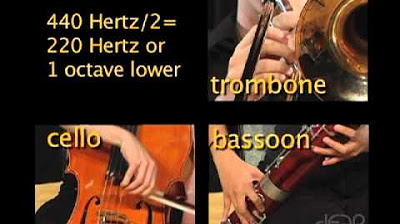Where Music Meet Science Part 2: Timbre and Complex Waves
Summary
TLDRIn this educational video, music instructor Scott Laird explores the science behind music, focusing on wave characteristics produced by different instruments. He starts with a perfect sine wave, a pure single frequency, and contrasts it with the complex waves generated by instruments like the cello and trombone. These complex waves consist of the fundamental frequency and harmonics, which together create an instrument's unique timbre. Laird also touches on how each instrument and human voice has a distinct set of harmonics, contributing to their individual sound. The lesson aims to bridge the gap between music and science, promising further exploration in upcoming lessons.
Takeaways
- 🎵 The lesson focuses on the study of waves generated by musical instruments and their unique characteristics.
- 🌊 A sine wave, representing a perfect wave, is a pure single frequency and is not commonly found naturally.
- 📈 The amplitude of a wave, or its height, corresponds to the volume of the sound, with taller waves indicating louder sounds.
- 🎶 The fundamental frequency is the primary pitch we hear, while other frequencies present are called harmonics.
- 🎻 The cello's wave pattern is more complex than a sine wave, indicating the presence of multiple frequencies and amplitudes.
- 👂 We can perceive the fundamental pitch of an instrument, but not the individual harmonics seen in the wave graph.
- 🎷 The trombone's wave pattern, while similar to the cello's in fundamental frequency, has distinct harmonics and amplitudes.
- 🎺 The clarinet's harmonics share similarities with the cello and trombone but also have unique differences.
- 🗣️ Even when singing the same pitch, different human voices produce distinct wave patterns due to their unique harmonics.
- 🔍 The lesson concludes with a teaser for the next lesson, which will explore the relationship between harmonics and musical notes.
Q & A
What is the main focus of the lesson presented by Scott Laird?
-The main focus of the lesson is to explore the waves generated by various musical instruments and their unique characteristics, specifically focusing on the concept of complex waves and their harmonics.
What is a sine wave and why is it significant in the context of this lesson?
-A sine wave is a perfect wave that represents a pure single frequency. It is significant because it serves as a basis for understanding more complex waves generated by musical instruments, which are composed of multiple sine waves.
Why does Scott Laird choose a frequency of 220 Hertz for the lesson?
-Scott Laird chooses 220 Hertz because it is in the middle of the musical range and can be played by many instruments, making it a suitable frequency for demonstrating the principles discussed in the lesson.
What does the high point of a wave represent in terms of air molecules?
-The high point of a wave represents the place where air molecules are compressed together, indicating a point of high pressure.
How is the volume of a sound wave depicted in the diagram?
-The volume of a sound wave is depicted by the amplitude of the wave, with taller waves representing louder sounds and shorter waves representing quieter sounds.
What is the term for the unique sound produced by an instrument, which is a result of its complex wave?
-The unique sound produced by an instrument, which is a result of its complex wave, is called its 'Timbre'.
What are the frequencies represented in the cello's wave that Scott Laird discusses?
-The frequencies represented in the cello's wave, apart from the fundamental frequency of 220 Hertz, include 440, 660, and 880 Hertz.
What is the relationship between the frequencies 440 Hertz and 880 Hertz to the fundamental frequency of 220 Hertz?
-The frequencies 440 Hertz and 880 Hertz are higher octaves of the fundamental frequency of 220 Hertz, representing a doubling relationship in octaves.
How do the harmonics contribute to the unique sound of an instrument?
-The harmonics contribute to the unique sound of an instrument by combining with the fundamental frequency to create a complex wave, which results in the instrument's distinct Timbre.
What is the difference between the fundamental frequency and the harmonics in a sound wave?
-The fundamental frequency is the primary frequency that we identify as the pitch of the sound, while the harmonics are the additional frequencies present in the sound wave that give it its unique quality or Timbre.
Why do different instruments, even when playing the same pitch, have different sounds?
-Different instruments have different sounds because they produce unique sets of harmonics with varying amplitudes, which combine to form their distinct Timbres.
Outlines

Dieser Bereich ist nur für Premium-Benutzer verfügbar. Bitte führen Sie ein Upgrade durch, um auf diesen Abschnitt zuzugreifen.
Upgrade durchführenMindmap

Dieser Bereich ist nur für Premium-Benutzer verfügbar. Bitte führen Sie ein Upgrade durch, um auf diesen Abschnitt zuzugreifen.
Upgrade durchführenKeywords

Dieser Bereich ist nur für Premium-Benutzer verfügbar. Bitte führen Sie ein Upgrade durch, um auf diesen Abschnitt zuzugreifen.
Upgrade durchführenHighlights

Dieser Bereich ist nur für Premium-Benutzer verfügbar. Bitte führen Sie ein Upgrade durch, um auf diesen Abschnitt zuzugreifen.
Upgrade durchführenTranscripts

Dieser Bereich ist nur für Premium-Benutzer verfügbar. Bitte führen Sie ein Upgrade durch, um auf diesen Abschnitt zuzugreifen.
Upgrade durchführenWeitere ähnliche Videos ansehen

The Physics of Music: Crash Course Physics #19

Where Music Meet Science Part 3: Frequency and Harmonics

Where Music Meet Science Part 1: Pitch and Frequency

Rangkuman Materi SBK Kelas 8 Bab 4: Teknik Bermain Alat Musik Tradisional

MUSIC OF INDIA |Grade 8-Music|Quarter 3

Pembelajaran Notasi balok Seni Musik Dasar Kelas x SMK
5.0 / 5 (0 votes)
